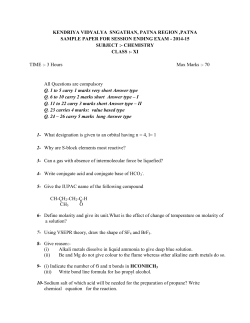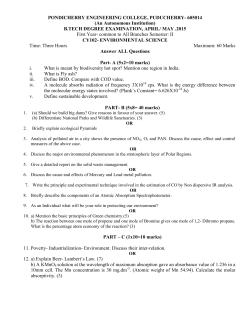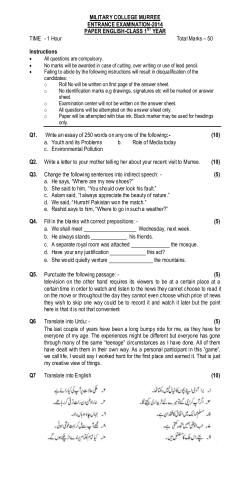
NYB Final F09 condensed version - John Abbott College Departments
Final NYB Fall 2009 Condensed Version (working spaces removed) 1 PLEASE NOTE: There is a set of multiple choice questions that was present on this exam, and have not been reproduced for the web-version. 1. (10 marks) Write the balanced molecular (formula) equation and the net ionic equation for the reactions between each of the following pairs of reactants. Be sure to include all states of reactants and products. a) Sodium phosphate (aq) and calcium chloride (aq) MOLECULAR (FORMULA) NET IONIC b) Nitric acid (aq) and sodium carbonate (aq) MOLECULAR (FORMULA) NET IONIC 2. (20 marks) A 0.410g sample of sodium fluoride is dissolved in 25.00mL of water and is then reacted with 50.00mL of 0.500mol/L calcium nitrate solution. After the mixture is filtered, 0.225g of precipitate is recovered. a) Write the net ionic equation for the reaction which occurs. b) Calculate the maximum mass of precipitate that could be formed (theoretical yield). c) Calculate the percentage yield for this reaction. d) Calculate the concentrations of the three major ions in the final solution. 3. (18 marks) In an experiment similar to one you performed, samples of three different solid metals were placed in four different solutions of metal ions. The data collected is presented in the table below: Al3+ Co2+ Cu2+ Pb2+ Al NR Reaction Reaction Reaction Cu NR NR NR NR Pb NR NR Reaction NR NR = No reaction a) Rank Al, Cu and Pb in terms of their strengths as reducing agents: Strongest --------------------------------------- Weakest b) Which species was the strongest oxidizing agent? Explain your answer. c) If metallic cobalt was tested with the four metal ion solutions, which combinations would lead to a reaction? Al3+ Co Co2+ Cu2+ Pb2+ Final NYB Fall 2009 Condensed Version (working spaces removed) 2 4. (15 marks) The decomposition of hydrogen peroxide (H2O2) was studied at 25°C. The reaction is shown below: H2O2(aq) H2O(l) + ½O2(g) H2O2 concentration was monitored over time, and the following plots were made: a) b) c) d) Write the rate law for this reaction. Calculate the rate constant at 25°C. (Don’t forget the units!) Determine the half life of H2O2 at 25°C. Explain or provide calculations. Calculate [H2O2] after 4.00 x 103 sec, if the initial concentration of H2O2 is 1.0 M. 5. (10 marks) Complete the following table. AQUEOUS SOLUTION 0.1 mol/L MOLECULAR FORMULA Acetic acid Ethanol Nitric acid Calcium bromide Sodium fluoride Ammonia CH3CH2OH ELECTROLYTE? (STRONG, WEAK, NON) APPROXIMATE pH 1 2-6 6-8 8-12 13-14 Final NYB Fall 2009 Condensed Version (working spaces removed) 3 6. (6 marks) Consider the following exothermic equilibrium in a closed container. A(g) + 3B(s) 5D(l) + E(g) + heat How will the reaction shift after each of the following changes? a) The temperature is raised b) More B is added (assume no volume change) c) The volume of the container is decreased d) Some of E is removed. 7. (15 marks) One of your experiments involved the determination of the equilibrium constant for the reaction Fe3+(aq) + SCN-(aq) (FeSCN)2+(aq) A student pipetted 10.00mL of 2.50x10-3mol/L iron (III) nitrate solution and then 2.00mL of 2.50x10-3mol/L NaSCN solution into a 25mL volumetric flask and added water up to the mark. From the absorbance of the solution, the concentration of (FeSCN)2+ was found to be 3.46x10-5mol/L. Calculate the value of the equilibrium constant for this reaction. 8. (5 marks) Consider the following diagram of an electrolytic cell: Power source Cathode Anode molten potassium chloride a) Indicate in the table whether the following statements are TRUE or FALSE. STATEMENT TRUE FALSE The anode is positive. Oxidation takes place at the anode. Electrons flow from anode to cathode. b) Write the half reaction that occurs at the anode. 9. (2 marks) List any two practical applications/real life examples of colligative properties. i. Ii. Final NYB Fall 2009 Condensed Version (working spaces removed) 4 10. (8 marks) Given that Kf = 1.86oC/m for water, calculate the freezing point temperature (oC) of the following aqueous solutions, assuming ideal behaviour: i. 0.50m sucrose ii. 0.50m sodium sulfate iii. Of the two solutions above, which one would have the higher boiling point? Explain briefly without calculations. 11. (8 marks) A volume of 0.10 mol/L sodium chloride solution is separated from an equal volume of 0.075 mol/L magnesium sulphate solution by a semi-permeable membrane as shown in Figure 1. The membrane is permeable to the passage of water only. Semipermeable membrane 0.10 mol/L sodium chloride Semipermeable membrane 0.075 mol/L magnesium sulfate Figure 1: Initial position Figure 2: Equilibrium position a) In Figure 2, draw the levels of the two solutions if the system is allowed to come to equilibrium. b) Briefly explain why you placed the levels where you did. 12. (8 marks) The following graph (sometimes called a vapour pressure curve) is a plot of the vapour pressure versus temperature for pure water. Pure water Vapour Pressure 1 atm a) On the same axes, sketch the vapour vapour pressure curve for 0.1mol/L sodium chloride. b) On the curves, indicate clearly the normal boiling point (at 1 atm) for pure water (Tb) and for 0.1mol/L sodium chloride (Tb′). Temperature c) Briefly explain why the two boiling points are different. 13. (10 marks) A 50.0 mL aqueous solution of barium hydroxide has a pH of 12.5. If 5.00 ml of 0.0200 mol/L sulfuric acid is added to this barium hydroxide solution, what will be the new pH of the resulting solution? Assume that the temperature stays constant at 25C. Final NYB Fall 2009 Condensed Version (working spaces removed) 5 14. (20 marks) The following titration curve was collected for the titration of ammonia with hydrochloric acid. pH versus Volume of Acid 15 pH 10 5 0 0.00 5.00 10.00 15.00 Volume of acid added (mL) a. Write the chemical equation for this neutralization reaction. b. What is the original concentration of the ammonia solution if 10.00 mL of the solution was titrated with 0.0923 mol/L hydrochloric acid? c. At what point on the titration curve is pOH = pKb? Briefly explain your answer. d. Calculate the pH at the equivalence point of this titration. 15. (15 marks) Consider a 375.0mL solution of 0.1000 mol/L acetic acid (Ka = 1.8x10-5) and 0.1550 mol/L barium acetate. What would be the pH if 7.5x10-4 moles of hydrochloric acid is added to the buffer? Assume no volume change due to this addition.
© Copyright 2025









